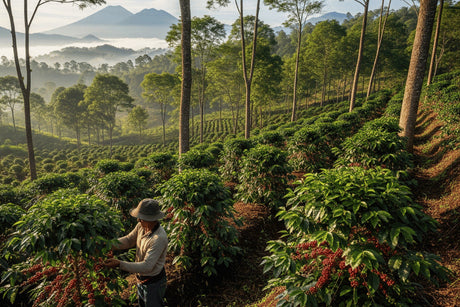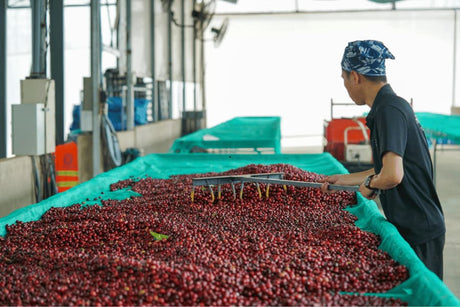March 2025
Nowadays, it's hard to think about anything else in the coffee industry besides pricing.
The problem is that this has been happening non-stop without respite for more than 12 months.
We try, but then, like a moth to the flame, it draws you back with incredible force - not only affecting our mindset, it's also impacting our creativity.
It is impossible to escape from like a dark cloud hovering overhead.
We are in March 2025 already, and the global coffee price has broken through historic barriers.
It's not good news for anyone; quite frankly, there is no cause for celebration.
Whilst record high prices are great for coffee farmers, it's bad for everyone else in the supply chain, from exporters, importers, roasters, retailers and the end-consumer, the coffee drinkers.
Unlike other commodities like fuel, fruit and vegetables, where the price volatility is reflected almost immediately at the retail or point-of-sale end, a sudden rise in coffee prices has traditionally not always "passed on" to coffee drinkers in the same timeframe due to large inventory lag in supply chains.
While raw (green) coffee is highly volatile, the selling prices for roasted coffee always try to remain relatively "static", with gentle movement over a 3- or 6-month cycle.
These price cycles are no longer viable as the market requires faster and more rapid responses to the sudden changes in raw coffee prices.
With green coffee doubling in the last 12 months, it's certainly new territory for everyone in the supply chain.
Traditionally, a change in coffee prices would take almost 3 to 6 months before the selling price of the roasted product altered.
Those days are gone, unfortunately.
With extreme shortages of raw coffee across all coffee-growing origins, the normal "lag" in supply chains of 3+ months has rapidly contracted to a period of weeks, with roasting companies holding significantly lower inventories.
If we look at Australian-based coffee importers, most of their warehouses are empty, and the normal "spot" market has disappeared for the first time in almost 50 years.
These are not good signs.
The sourcing of green coffee has changed from the simplicity of "buying what you want from a big list" to "buying only what is available from a short list".
This disruptive change changes may be irreversible.
So, let's unpack what's happening.
Global coffee prices remain largely influenced by speculation.
Mythical supply versus demand equation.
Certainly, that may make some sense, but unfortunately, most significant market movements are driven by large hedge funds. These traders have no interest in the physical inventory and profit from fluctuations in commodity futures.
On the one hand, coffee farmers hold out for higher prices; on the other, roasters are unwilling to pay the ransom.
It's a classic standoff.
The market becomes dysfunctional and easily prey to manipulation from trading patterns that make little sense.
There is no escape from the consequences of highly priced trades.
To stay in business, you need physical coffee to sell; hence, you pay the ransom for the raw materials.
Despite what people may think, there is no secret stash or special channel to buy coffee during these times of elevated prices - it just doesn't exist.
All players in the supply chain, from farmers, exporters and importers, are trying to maximize their profit, and nobody is willing to let go of coffee for a low price under any circumstances.
Undoubtedly, stockpiles of unsold raw coffee sit at their origin around the globe, waiting for the right moment when elevated prices will trigger a massive profit for the holder.
But wait a moment.
Extended periods of high-priced coffee will result in the average coffee drinker doing their sums trying to work out if they can either cut back or do without - otherwise known as demand destruction.
Elevated coffee prices will result in a level of decline in market demand, and whilst the conditions in previous cycles have led to direct price corrections, this time, people are saying it's not going to happen, and it seems everyone is bullish for coffee prices to stay high.
The gap between supply and demand is so great that consensus opinion indicates elevated coffee prices are here to stay for at least 18 months.
What does all this mean for coffee drinkers?
Retail pricing will continue to rise over the next few months as the impact of new crop arrivals priced at +$8/kg starts to bite.
In March 2025, we see coffee brands using a blend of coffees from early 2024 crops mixed with newer harvest at the current market of +$9/kg.
As more of the early 2024 crop coffees are consumed, which will happen rapidly over the next few months, average green/raw cost starts to lift dramatically.
Some coffee brands have no 20thatcrop remaining and are fully exposed to the current market pricing.
We believe that a peak will occur around July and August 2025 as the full impact of the price cycle manifests in roasting and selling (retail) sides.
Be prepared for a price increase of another $2 to $4 per kilo from May through August, which may be even higher.
Beyond the high raw/green coffee pricing, supply chains still have major shipping challenges.
The availability of containers, particularly food-grade containers capable of shipping raw/green coffee, is still a big problem, along with limited shipping slots.
Another emerging factor is the impact of Trump's tariffs.
While most people may think the US tariffs are isolated from imports into America, there is a side effect in how the volatility of the USD trading patterns influences coffee prices.
All raw/green coffee is traded in USD.
Historically, whenever the USD tanks, raw coffee prices rise as farmers still seek to receive their prices from any weakening in exchange rates.
As we see the USD diving, can we expect the price of coffee to rise in comparison?
What can we do in response to higher pricing?
At myCuppa, we have tried to contain the escalating price rises as best we can.
We can't buy 2024 crop coffee - there is none.
So today, we are operating on razor-thin margins and praying that the market cycle will revert or retreat during 2025.
The longer it stays high, the more likely we will have to revise pricing again.
Our 2024 crop coffees are almost gone, and new crops have been flowing into our warehouse almost weekly during 2025, with more to come over the next few months.
These new arrivals are significantly more expensive compared to the previous harvest.
In some cases, we have elected to "stock out" certain origins or coffees that are expensive or represent poor value on a price versus flavour basis.
Some origins are proving challenging, such as Rwanda, Burundi, Guatemala, Ethiopia, Tanzania and Kenya.
Our strategy is to look at origins that have not traditionally been part of our normal sourcing plan so that we can continue to offer exceptional-tasting coffees at great value prices.
Stay tuned as we navigate through these uncertain times.









